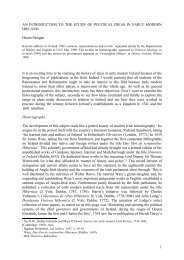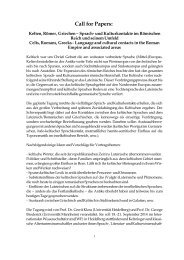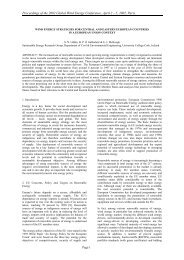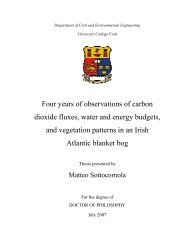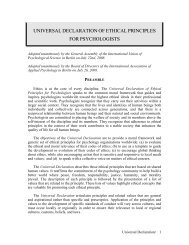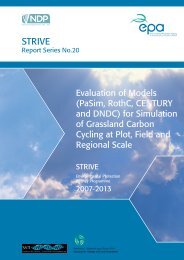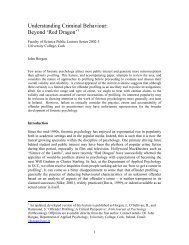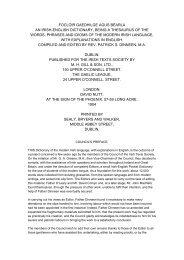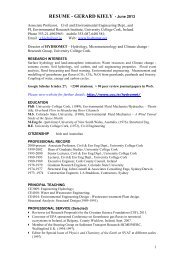2013 - University College Cork
2013 - University College Cork
2013 - University College Cork
Create successful ePaper yourself
Turn your PDF publications into a flip-book with our unique Google optimized e-Paper software.
ESTABLISHING THE SCIENTIFIC BASES AND<br />
TECHNICAL PROCEDURES AND STANDARDS TO<br />
RECOVER EUROPEAN FLAT OYSTER PRODUCTION<br />
THROUGH STRATEGIES TO TACKLE THE MAIN<br />
CONSTRAINT BONAMIOSIS (OYSTERECOVER)<br />
Research Centre/Department/School:<br />
AFDC, School of Biological, Earth & Environmental Sciences<br />
Contact PI: Dr Sarah Culloty, s.culloty@ucc.ie<br />
Researchers: Grace Flannery, Jeanette Carlsson,<br />
Dr Sharon Lynch, Dr Jens Carlsson, Prof. Tom Cross<br />
Start Year: 2010 – End Year: <strong>2013</strong><br />
Funding Body: EU FP7 Funding Programme<br />
Funding: €730,894<br />
Collaborating Partners: Ireland, UK, Denmark, the Netherlands, France, Spain<br />
Web: http://afdc.ucc.ie<br />
Research Projects Listing<br />
The European flat oyster, Ostrea edulis, has been part of the human diet for many centuries and is<br />
farmed in many European countries including Ireland, France, Spain and Holland. In the first half<br />
of the 20th century stocks were greatly reduced due to overfishing and mismanagement of oyster<br />
beds but populations were completely devastated in the 1970’s and 80’s with the introduction of<br />
two invasive parasites, Marteilia refrigens and Bonamia ostreae. B. ostreae has no implications<br />
for human health but it is a serious disease of flat oysters with up to 80% mortality occurring<br />
in populations and is listed as a notifiable disease. Production numbers in Ireland have significantly<br />
reduced despite much research, several breeding programmes and the establishment of<br />
new management practices to tackle the parasite. Many aspects of the biology of B. ostreae remain<br />
unknown; for example, uncertainties exist about its life cycle, and the possibility that species other<br />
than oysters could act as vectors. The recovery of flat oyster production, achieved through the<br />
control of B. ostreae, would be an important boast to the shellfish industry in Europe.<br />
OYSTERECOVER is an industry led project funded under the EU FP7 Capacities programme. It<br />
is a three year collaborative project involving seven research centres and seven European shellfish<br />
producers and representative assocaitions from six countries – Ireland, UK, Denmark, the Netherlands,<br />
France, Spain. The main objective of the project is to aid conservation of the native flat<br />
oyster O. edulis ultimately resulting in more production of this oyster throughout Europe.<br />
KEY PUBLICATIONS & OUTPUTS<br />
Flannery, G., Lynch, S. & Culloty S. DATE. An update on the prevalence<br />
of Bonamia ostreae at two Irish sites. 5th Microcell Working<br />
Group, Lelystad, the Netherlands. Oral Presentation.<br />
Flannery, G., Lynch, S., Carlsson, J., Cross, T., Culloty, S.C. 2012. An<br />
assessment of the ongoing impact of the pathogen Bonamia ostreae<br />
in the European flat oyster Ostrea edulis at two sites with different<br />
histories of exposure. National Shellfisheries Association, 2012<br />
Seattle, America. Oral Presentation.<br />
Flannery, G., Lynch, S., Carlsson, J., Cross, T., Culloty, S.C. 2011.<br />
The current status in Ireland of the pathogen Bonamia ostreae in<br />
the European flat oyster Ostrea edulis. Shellfish Restoration 2011,<br />
Stirling, Scotland. Poster Presentation.<br />
RESEARCH PROJECTS



